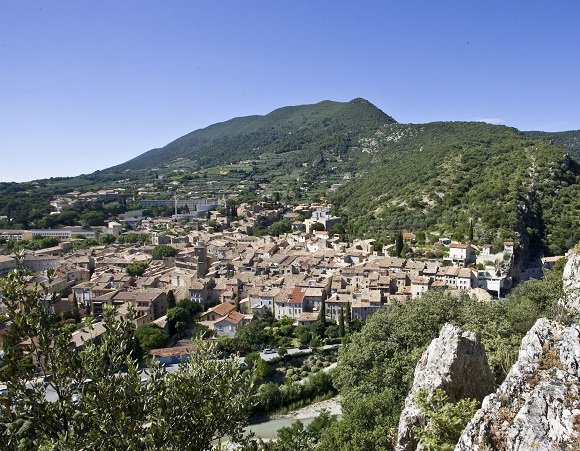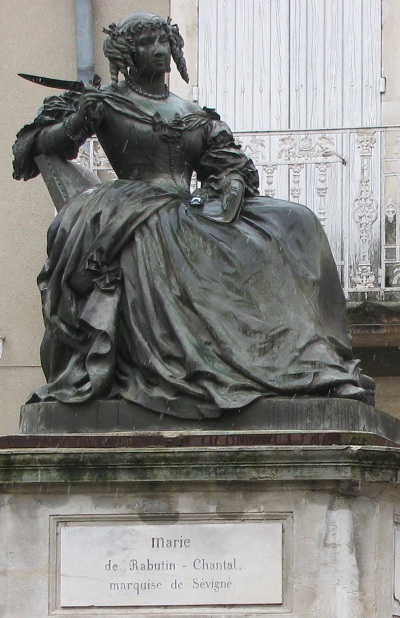
View over Nyons. Photo Lionel Pascale/ADT Drome.
Some impressions and practical information concerning the area covered in Parts 1 and 2 of “Eat like a sixth grader, drink like a wine enthusiast,” including Nyons, Taulignan and Grignan and featuring olives, lavender, silk and Madame de Sévigné.
* * *
Nyons
After dinner I set out alone from the Hotel Colombet to haphazardly explore the cobbled streets and alleys of the oldest portion of Nyons. I eventually made my way an ancient bridge arching high over the narrow Eygues River. It was dark. The bridge was blocked at my end. In the dark it didn’t appear to go anywhere one would want venture at night. The area felt abandoned, forgotten.
It was just an impression on a cold night but the truth didn’t matter. There’s an attractive mystery that comes from wandering through an old town at night, a hesitation before turning corners and walking under archways, a mix at apprehension and relieve at seeing someone walking towards you in the opposite direction against a backdrop of stones walls and strangely cast shadows. It’s the reason I’d set out alone rather than accept an invitation from the others to visit the town with them once they’d finished the wine. I didn’t want to visit; I wanted to explore.
In daylight the following morning the mystery had evaporated. The shops were opening. The ancient bridge was now interesting for its form rather than its enigma. The shutters and the rooftops of the old town and the vegetation along the hill on the opposite side of the bridge all spoke of Provence.
 Nyons is best known for the table olives and olive oil produced in the surrounding area. The olive oil is a smooth and light with a mild taste of spice and a nip of pepper. The unlikely traveler passing through the area from the end of November through December can enjoy the view and buzz of the olive harvest. Visitors in summer will more likely be seeking out lavender fields in bloom when exploring the area of Provence and Haute Provence, including the Nyons region.
Nyons is best known for the table olives and olive oil produced in the surrounding area. The olive oil is a smooth and light with a mild taste of spice and a nip of pepper. The unlikely traveler passing through the area from the end of November through December can enjoy the view and buzz of the olive harvest. Visitors in summer will more likely be seeking out lavender fields in bloom when exploring the area of Provence and Haute Provence, including the Nyons region.
The cultivation of lavender has increased substantially since the early 1980s in the provençal areas of southeast France (Drome, Alpes de Haute Provence, Haute-Alpes, Vaucluse), whose land and various altitudes lend themselves to growing three main types of lavender—aspic lavender, “true” lavender and lavandin. Lavandin, the most ordinary of the three, is what grows in the lower-lying areas around Nyons.
Nyons has a distillery for lavender and other aromatic plants, Bleu Provence, one of about 120 such distilleries in France. Visitors can learn about the production and distilling of lavender now and in the past I the distillery’s little museum open. There’s also a selling all things lavender. See Bleu Provence’s website for opening times and entrance fees. www.distillerie-bleu-provence.
For suggestions of itineraries of “Lavender Roads” throughout Provence and the Alps that can by car, motorcycle, even bike see this official tourist board website.

Taulignan
Taulignan is a small town that’s a 20-minute (12-mile) drive from Nyons. It has a population of 1600 of which only 160 within the medieval walls. A quick walk through that medieval portion gave the impression of a gated community that hasn’t yet figured out parking restrictions. I suspect that it’s deserving of a more leisurely stroll, however Taulignan’s Silk Museum was my actual destination.
The history of silk production is one of those many things that I’d hardly think myself curious about, but once inside the museum I found myself absorbed for a good 30 minutes by the history of silk production beginning in the area from the 17th century until the end of the 19th century, with a particular emphasis on 18th- and 19th-century developments in techniques and machinery. There are explanatory panels in French and English. The museum also tells the story of local silk factories that housed and employed orphans and disinherited girls.
Locally produced silk thread was transported to Lyon, formerly the center for the production of silk fabrics and products in France. France no longer produces silk though a tiny remnant of the silk fabric and garment business still exists in Lyon. The agriculture surrounding Taulignan, once marked by up to 13,200 mulberry trees and their silk worms, is now devoted to vines for Cote du Rhone wines and lavender with the occasional honey producer and truffle hunter, as throughout the region.
The Silk Museum (Musée de la Soie) is located just outside the main opening in the medieval ramparts. See the musem’s website for opening times and entrance fees. More information (in French only) about the village itself can be found here.
Grignan
The hilltop castle of Grignan, four miles from Taulignan, can be seen in the distance as you approaches from the plain. Its architecture and interior are less notable than its place in French literary history. This is where Madame de Sévigné, the celebrated figure of 17th-century epistolary literature, would come to visit her daughter Madame de Grignan, with whom she otherwise and frequently corresponded with by letter.

“My heart is at rest when it is next to you” (Mon cœur est en repos quand il est auprès de vous), she wrote upon leaving her daughter after a visit in 1673, before concluding “alas, here we are back in letters” (hélas ! nous revoilà dans les letters.) Reading that letter makes me feel nostalgic for the days not so long ago when people were more interested in voice communication rather than in texting.
Madame de Sévigné’s collected letters reveal this intense mother-daughter relationship as well as life, fashion, literature and politics at the Court of Versailles during the time of Louis XIV. Those letters are likely to be on the curriculum of those students now eating 25% organic food at lunch throughout the department.
The countryside of Grignan, Tricastin and the Popes Enclave, all in this same general area, is leading producer of the hunted black truffle “tuber melanosporum.” Grignan is just five miles north of Europe’s largest truffle market held on Saturdays from mid-November to mid-March in the town of Richerenches (see this article on France Revisited). Truffles are integrated into menus throughout the region at that time of year, in dishes such as the creamy scrambled eggs with truffles (brouillade de truffes) that I had just outside of the old town at one of the finer local restaurants La Table des Delices.
For a photo-reportage about this region in winter see here.
End note for cyclists: We are just north of Mont Ventoux, the largest mountain in the sector, known to cyclists both amateur and professional for challenging gradients up to 10%.
© 2012, Gary Lee Kraut
– Return to Part 1 of Drome Provencale: Eat Like a Sixth Grader, Drink Like a Wine Enthusiast
– Return to Part 2 of Drome Provencale Eat Like a Sixth Grader, Drink Like a Wine Enthusiast


Gary,
This is a wonderful series of articles on a less traveled part of the south of France which brings many rewards because it is a bit less traveled. Another lovely small town worth visiting near Nyons is Buis-les-Baronnies. It feels very residential but friendly; it is a good place to purchase local oils and spices. An interesting reminder for those who admire the letters of Madame de Sévigné is that Thornton Wilder’s Bridge of Saint Luis Rey incorporates characters modeled on the relationship of Madame de Sévigné and her daughter and includes segments of gorgeous correspondence influenced by the original letters.